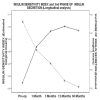LONG-TERM IMPROVEMENT OF GLUCOSE HOMEOSTASIS AND BODY COMPOSITION IN PATIENTS UNDERGOING LAPAROSCOPIC SLEEVE GASTRECTOMY
- PMID: 31149300
- PMCID: PMC6516409
- DOI: 10.4183/aeb.2018.477
LONG-TERM IMPROVEMENT OF GLUCOSE HOMEOSTASIS AND BODY COMPOSITION IN PATIENTS UNDERGOING LAPAROSCOPIC SLEEVE GASTRECTOMY
Abstract
Context: Laparoscopic sleeve gastrectomy (SG) has gained popularity as a metabolic procedure, but its long-term effectiveness for Romanian patients remains unclear.
Objectives: To assess the long-term efficacy of SG for Romanian patients and to evaluate the differences between 5 years and 1 year follow-up.
Design: A longitudinal, prospective analysis of collected data from 68 patients undergoing SG between 2009 and 2014 was performed. Long-term outcomes at 5 years were analyzed in terms of total weight loss (%TWL), excess weight loss (%EWL), body composition and glucose homeostasis.
Subjects and methods: All patients meeting the standard criteria for SG before inclusion were prospectively enrolled in the study. Of the 68 patients, eight were lost to follow-up, therefore, 60 patients (41.7±12.5 years, baseline body mass index [BMI] 44.6±9.9Kg/m2) were analyzed.
Results: The BMI decreased at 12 months with 30.7% from the preoperative BMI (p<0.001) and subsequently stabilized at 5 years.TWL and EWL were 30.6% and 83.1%, respectively at 1 year, with a slightly increase at 5 years.Therapeutic success rate (%EWL≥50) and diabetes remission rate (Buchwald criteria) were 93.3% and respectively 63.6% at 5 years. Insulin sensitivity index and metabolic clearance rate of glucose increased with 92.5% and 60.1% respectively, in the third month from baseline (p<0.001), while estimated second phase of insulin secretion decreased with 7.9% in the first month postoperatively (p=0.04), remaining stable afterwards.
Conclusions: SG was effective in terms of %EWL, body composition and glucose homeostasis improvement for Romanian patients, the outcomes stabilizing after 1 year follow-up.
Keywords: Body composition; Glucose homeostasis; Percentage excess body mass index loss; Sleeve gastrectomy.
Conflict of interest statement
The authors declare that they have no conflict of interest.
Figures



References
-
- World Health Organization GLOBAL STATUS REPORT on noncommunicable diseases (2014) Attaining the nine global noncommunicable diseases targets; a shared responsibility. 2014. http://apps.who.int/iris/bitstream/10665/148114/1/9789241564854_eng.pdf. Accessed 25 March 2016.
-
- OECD . OECD Publishing; 2014. Health at a Glance: Europe 2014 completed with Eurostat Statistics Database. (2014) . Accessed 20 March 2016. - DOI
-
- Popa S, Moţa M, Popa A, Moţa E, Serafinceanu C, Guja C, Catrinoiu D, Hâncu N, Lichiardopol R, Bala C, Popa A, Roman G, Radulian G, Timar R, Mihai B. Prevalence of overweight/obesity, abdominal obesity and metabolic syndrome and atypical cardiometabolic phenotypes in the adult Romanian population: PREDATORR study. J Endocrinol Invest. 2016;39(9):1045–1053. - PubMed
-
- Mihalache L, Graur L, I, Popescu D, Boiculese L, Badiu C, Graur M. The Prevalence of the Metabolic Syndrome and Its Components in A Rural Community. Acta Endo (Buc) 2012;8(4):595–606.
-
- Moţa E, Popa SG, Moţa M, Mitrea A, Penescu M, Tuţă L, Serafinceanu C, Hâncu N, Gârneaţă L, Verzan C, Lichiardopol R, Zetu C, Căpuşă C, Vlăduţiu D, Guja C, Catrinoiu D, Bala C, Roman G, Radulian G, Timar R, Mihai B. Prevalence of chronic kidney disease and its association with cardio-metabolic risk factors in the adult Romanian population: the PREDATORR study. Int Urol Nephrol. 2015;47(11):1831–1838. - PubMed
LinkOut - more resources
Full Text Sources
